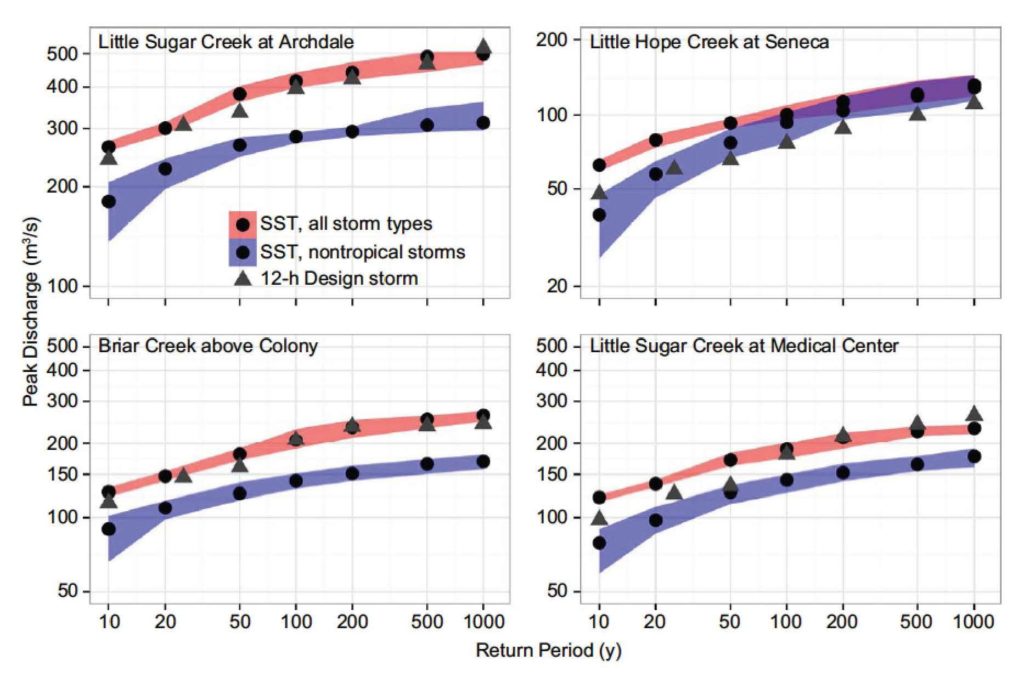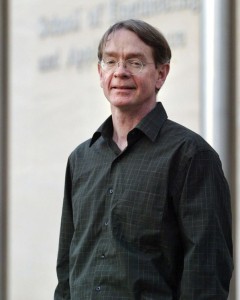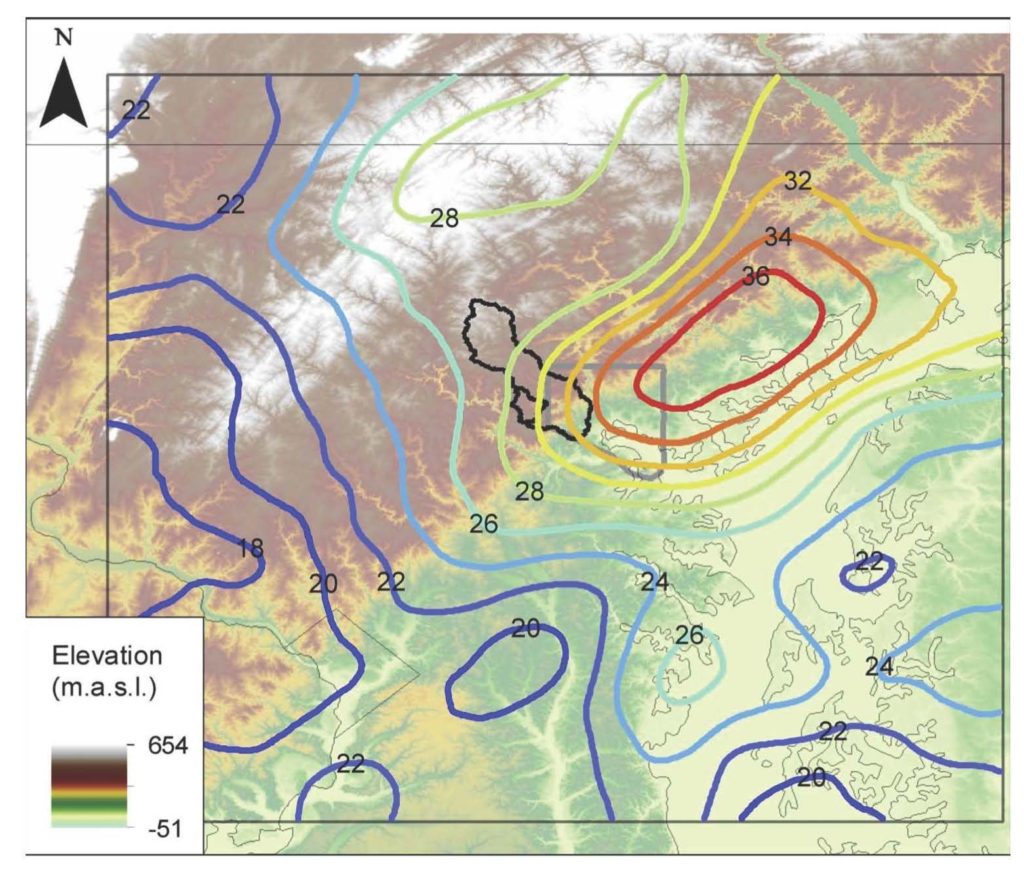Project B2-2a: Flood Hydrology and Rainfall Frequency
James A. Smith, PhD
Princeton University
Civil & Environmental Engineering
Objective: The objective of this study is to develop a predictive understanding of urban flood hydrology that can be used to assess the effectiveness of “urban water solutions”, especially Green Infrastructure technologies, in reducing flood hazards.
Research Question: How does urban infrastructure alter flood hazards and how can flood hazards be reduced through novel urban water solutions.
Overview: In this project, we will examine the hydrology, hydrometeorology and hydroclimatology of urban flooding through numerical modeling and data-driven studies that focus on urban watersheds in Baltimore, Miami, Denver, Phoenix (and the broader Sun Corridor region), Los Angeles and Portland.
We will develop long-term, high-resolution radar rainfall fields for each of the six urban regions for hydrologic modeling studies and for examining the hydroclimatology of urban flash flooding. In previous studies, it has been shown that high-resolution radar rainfall fields provide an exceptional resource for assessing urban flooding.
The six urban study regions provide a broad range of settings for examining urban flooding, both in terms of land surface process and in terms of rainfall climatology. We will develop and implement hydrologic models for each of the study regions. Modeling analyses will be used to address core scientific questions and assess the effectiveness of urban water solutions in reducing flood hazards.
Journal Articles
- Chaney, M. M., Smith, J. A., & Baeck, M. L. (2022). Range Dependence of Polarimetric Radar Estimates for Extreme Flood-Producing Rainfall in Urban Watersheds, Journal of Hydrometeorology, 23(8), 1205-1226 https://doi.org/10.1175/JHM-D-21-0191.1
- Cristiano, E., ten Veldhuis, M.-C., Wright, D. B., Smith, J. A., & van de Giesen, N. (2019). The influence of rainfall and catchment critical scales on urban hydrological response sensitivity. Water Resources Research, 55 (4),3375 – 3390, 2019. https://doi.org/10.1029/2018WR024143
- Miller, A. J., Welty, C., Duncan, J. M., Baeck, M. L., & Smith, J. A. (2021). Assessing urban rainfall-runoff response to stormwater management extent. Hydrological Processes, 35( 7), e14287. https://doi.org/10.1002/hyp.14287
- Ryu, Y.-H., J. A. Smith, M. L. Baeck and E. Bou-Zeid, The influence of land-surface heterogeneities on heavy convective rainfall in the Baltimore-Washington metropolitan area, Monthly Weather Review, 144, 553–573, 2016. http://dx.doi.org/10.1175/MWR-D-15-0192.1
- Smith, B. K., J. A. Smith and M. L. Baeck, Flash flood producing storm properties in a small urban watershed, J. of Hydrometeorology, 17, 2631 – 2647, 2016. http://dx.doi.org/10.1175/JHM-D-16-0070.1
- Smith, J. A., A. A. Cox, M. L. Baeck, Long Yang and P. Bates, Strange floods: the upper tail of flood peaks in the US, Water Resources Research, 54 (2018). https://doi.org/10.1029/2018WR022539
- Stephens, T. and Bledsoe, B (2017). Urban floodplains: Changing climate, land use, and river channels. Regions Magazine https://doi.org/10.1080/13673882.2017.11878968 .
- Su, Y. and J. A. Smith, An atmospheric water balance perspective on extreme rainfall potential for the contiguous US, Water Resources Research, 57, e2020WR028387, 2021. https://doi.org/10.1029/2020WR028387
- ten Veldhuis, M.-c., Z. Zhou, L. Yang, S. Liu and J. A. Smith, The role of storm dynamics in controlling urban flood response, Hydrology and Earth System Sciences, 22, 417-436, 2018 https://doi.org/10.5194/hess-22-417-2018 .
- Wang, W., J. A. Smith, P. Ramamurthy, M. L. Baeck, E. Bou-Zeid and T. M. Scanlon, On the correlation of water vapor and CO2: application to flux partitioning of evaporation, Water Resources Research, 52, 9452–9469, doi:10.1002/ 2015WR018161 https://doi.org/1002/2015WR018161 , 2016.
- Yang, L., J. A. Smith, M. L. Baeck and Y. Zhang, Flash flooding in small urban watersheds: storm event hydrologic response, Water Resources Research, 52(6), pp. 4571 – 4589, 2016.. DOI: https://doi.org/1002/2015WR018326.
- Yang, L., J. A. Smith, M. L. Baeck, B. K. Smith, F. Tian and D. Niyogi, Structure and evolution of flash flood producing storms in a small urban watershed, J. of Geophysical Research (Atmospheres),121, 3139–3152, 2016. DOI: 10.1002/2015JD024478 https://doi.org/1002/2015JD024478.
- Yang, L., J. Smith, M.L. Baeck, E. Morin, and D.C. Goodrich, 2017: Flash Flooding in Arid/Semiarid Regions: Dissecting the Hydrometeorology and Hydrology of the 19 August 2014 Storm and Flood Hydroclimatology in Arizona. J. Hydrometeor., 18, 3103–3123, https://doi.org/10.1175/JHM-D-17-0089.1
- Yang, L., J. A. Smith, M. Liu and M. L. Baeck, Extreme rainfall from Hurricane Harvey (2017): Intercomparisions of WRF simulations and polarimetric radar fields, Atmospheric Research, 223, 114 – 131, 2019. http://adsabs.harvard.edu/abs/2017AGUFMNH23E2866Y
- Yang, L. and J. A. Smith, Sensitivity of extreme rainfall to atmospheric water vapor in the arid/semi-arid Southwestern US: Implications for PMP estimates, J. Geophysical Research (Atmospheres), 123, 1638 – 1656, 2018. https://doi.org/10.1002/2017JD027850
- Yang, Long, J A. Smith, M. L. Baeck and E. Morin, Flash flooding in arid/semi-arid regions: climatological analyses of flood-producing storms in central Arizona during the North American Monsoon, J. Hydrometeorology, 20, 1449 – 1471, DOI: 10.1175/JHM-D-19-0016.1, 2019.
- Yang, Long, J. A. Smith and D. Niyogi, Urban impacts on extreme monsoon rainfall and flooding in complex terrain, Geophysical Research Letters, 46(11), 5918 – 5927, 2019. https://doi.org/10.1029/2019GL083363
- Yang, Yan, Long Yang, J. A. Smith, M. L. Baeck and G. Ni, Regional impacts of urban irrigation on surface heat fluxes and rainfall in central Arizona, J. Geophysical Research, 124(2), pp. 6393 – 6410, 2019. https://doi.org/10.1029/2018JD030213
- Yang, L., J. A. Smith, M. Liu and M. L. Baeck, Extreme rainfall from Hurricane Harvey (2017): Intercomparisions of WRF simulations and polarimetric radar fields, Atmospheric Research, 223, 114 – 131, 2019 https://doi.org/10.1016/j.atmosres.2019.03.004
- Zhang, W., G. Villarini, G. A. Vecchi and J. A. Smith, Urbanization exacerbated the rainfall and flooding by Hurricane Harvey in Houston, Nature Climate Change, 563, 384 – 388, 2018. doi: 10.1038/s41586-018-0676-z
- Zhou, Z., J. A. Smith, L. Yang, M. L. Baeck, M. Chaney, M.-C. ten Veldhuis, and S. Liu, The Complexities of Urban Flood Response: Hydrologic Analyses for the Charlotte, North Carolina Metropolitan Region, Water Resources Research, 53(8), pp. 7401–7425, 2017. DOI: 10.1002/2016WR019997 https://doi.org/10.1002/2016WR019997
- Zhou, Z., J. A. Smith, D. B. Wright, M. L. Baeck, L. Yang, and S. Liu, Rainfall frequency analysis in a complex physiographic setting based on Stochastic Storm Transposition, Water Resources Research, 55, 2019. https://doi.org/10.1029/2018WR023567
- Zhou, Z., J. A. Smith, M. L. Baeck, D. B. Wright, B. K. Smith and S. Liu, The impact of spatio-temporal structure of rainfall on flood response over a small urban watershed: An approach coupling Stochastic Storm Transposition and hydrologic modeling, Hydrology and Earth System Science, 25, 4701 – 4717, 2021. https://doi.org/10.5194/hess-25-4701-2021
- Zhou, Z., J. A. Smith, D. B. Wright, M. L. Baeck, L. Yang, and S. Liu, Rainfall frequency analysis in a complex physiographic setting based on Stochastic Storm Transposition, Water Resources Research, 55(3), 1871 – 1889. https://doi.org/10.1029/2018WR023567
Updated: October 2022
Dissertations
- Chanye, Molly (2021). Polarimetric Radar Analyses of Extreme Rainfall. PhD Dissertation: Civil and Environmental Engineering, Princeton University. Web: http://arks.princeton.edu/ark:/88435/dsp018049g820w
Updated: October 2022
Hydrologic Models
The experimental approach will center on:
- Development of high-resolution radar rainfall fields for the six urban regions
- Development and implementation of hydrologic models for gaged watersheds in the six urban regions
- Hydroclimatological studies of urban flooding in the six urban regions.
We will develop hydrologic models that can be used for examining the consequences of urban water solutions (especially those based on Green Infrastructure technologies) and climate change. We will develop stochastic storm transposition models for assessing rainfall and flood frequency in urban watersheds.
Related Materials
 James A. Smith, PhD – Principal Investigator
James A. Smith, PhD – Principal Investigator
William and Edna Macaleer Professor of Engineering and Applied Science
Civil and Environmental Engineering
Princeton University
Voice: (609) 258-4615
Email: jsmith@princeton.edu
Dr. Smith’s research interests concern the hydrology, hydraulics and hydrometeorology of extreme floods. Hydrometeorological studies have centered on development of technologies for measuring rainfall from weather radar, stochastic modeling of the space-time structure of rainfall and microphysical studies of extreme rainfall from organized systems of thunderstorms. Smith’s research group has been involved in numerous hydrometeorological field campaigns, most recently in connection with the Baltimore Ecosystem Study (BES), a component of the NSF LTER program. Field studies in the BES have also examined the heterogeneity of hydrologic response in urbanizing watersheds, the stability of the channel-floodplain system in urban drainage networks and the hydraulics of extreme floods in urban rivers. In addition to field campaigns focused on intensively monitoring research watersheds, Smith and his colleagues have been extensively involved in field studies of major floods in the United States
Mary Lynn Baeck – Hydrometeorology Programmer
Civil and Environmental Engineering
Princeton University
Email: mlbaeck@princeton.edu
Molly M. Chaney – Graduate Student
Civil and Environmental Engineering
Princeton University
Email: mchaney@exchange.Princeton.EDU


